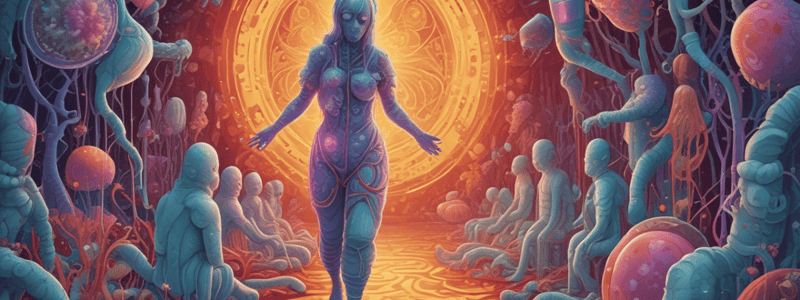Podcast
Questions and Answers
What is the definition of infection?
What is the definition of infection?
- A disorder of structure or function in the host that adversely impacts the host
- A disorder of structure or function in the host that is a result of physical injury
- A disease caused by a pathogenic microorganism
- The invasion and multiplication of pathogens in an individual or population (correct)
What is the term for diseases that can be spread directly or indirectly from one animal to another?
What is the term for diseases that can be spread directly or indirectly from one animal to another?
- Infectious diseases
- Pathogenic diseases
- Invasive diseases
- Communicable diseases (correct)
What is the term for the ability of a pathogen to cause disease?
What is the term for the ability of a pathogen to cause disease?
- Dispersal efficiency
- Inoculation dose
- Survival efficiency
- Pathogenicity (correct)
What is the importance of Koch's postulates?
What is the importance of Koch's postulates?
What is One Health?
What is One Health?
What is the term for the study of the cause of disease?
What is the term for the study of the cause of disease?
Who is credited with discovering the bacteria responsible for anthrax, tuberculosis, and cholera?
Who is credited with discovering the bacteria responsible for anthrax, tuberculosis, and cholera?
What type of relationship exists between a microbe and its host when neither is harmed and one or both derive a benefit?
What type of relationship exists between a microbe and its host when neither is harmed and one or both derive a benefit?
What is the term for a microorganism that is capable of causing disease?
What is the term for a microorganism that is capable of causing disease?
What is the term for a microorganism that must produce disease to transmit and thereby survive evolutionarily?
What is the term for a microorganism that must produce disease to transmit and thereby survive evolutionarily?
Who is credited with demonstrating that a silkworm disease was contagious and caused by a microscopic fungus?
Who is credited with demonstrating that a silkworm disease was contagious and caused by a microscopic fungus?
Which type of pathogen requires significant impairment of the host's immunity to cause disease?
Which type of pathogen requires significant impairment of the host's immunity to cause disease?
What is the term for a microorganism that is transmitted to the host from an environmental source such as water or soil?
What is the term for a microorganism that is transmitted to the host from an environmental source such as water or soil?
What type of pathogen can infect and multiply in hosts, but is also capable of multiplying in the environment?
What type of pathogen can infect and multiply in hosts, but is also capable of multiplying in the environment?
What is the term for a microorganism that is a colonizer or pathogen on animals and that can be transmitted to humans?
What is the term for a microorganism that is a colonizer or pathogen on animals and that can be transmitted to humans?
What is the term for a microorganism that is not a commensal, but can produce asymptomatic infections?
What is the term for a microorganism that is not a commensal, but can produce asymptomatic infections?
How do commensal pathogens enter the host?
How do commensal pathogens enter the host?
What is the essential trait for obligate pathogens?
What is the essential trait for obligate pathogens?
Why may Koch's postulates not be fulfilled for some pathogens?
Why may Koch's postulates not be fulfilled for some pathogens?
What occurs during the incubation stage of an infectious disease?
What occurs during the incubation stage of an infectious disease?
Who first observed microorganisms?
Who first observed microorganisms?
What is the term for a microorganism that is invisible to the naked eye?
What is the term for a microorganism that is invisible to the naked eye?
What type of microorganism is capable of causing disease?
What type of microorganism is capable of causing disease?
What is the term for a microorganism that is a normal inhabitant of the animal body?
What is the term for a microorganism that is a normal inhabitant of the animal body?
Who developed the pasteurization process and developed vaccines against rabies and anthrax?
Who developed the pasteurization process and developed vaccines against rabies and anthrax?
What is the size order of microorganisms, from smallest to largest?
What is the size order of microorganisms, from smallest to largest?
What is the primary characteristic of an opportunistic pathogen?
What is the primary characteristic of an opportunistic pathogen?
Which type of pathogen can cause disease in humans through direct contact with an animal or its products?
Which type of pathogen can cause disease in humans through direct contact with an animal or its products?
What is the term for a microorganism that is commonly found within the indigenous microbiota and can cause disease in normal hosts with some regularity?
What is the term for a microorganism that is commonly found within the indigenous microbiota and can cause disease in normal hosts with some regularity?
What type of pathogen can cause disease through vectors such as ticks?
What type of pathogen can cause disease through vectors such as ticks?
What is the primary characteristic of an obligate pathogen?
What is the primary characteristic of an obligate pathogen?
What is necessary for a pathogen to establish a unique habitat within the host?
What is necessary for a pathogen to establish a unique habitat within the host?
Which of the following is NOT a limitation of Koch’s postulates?
Which of the following is NOT a limitation of Koch’s postulates?
What occurs during the prodromal stage of an infectious disease?
What occurs during the prodromal stage of an infectious disease?
What is the essential trait for obligate pathogens?
What is the essential trait for obligate pathogens?
What is the primary difference between infection and disease?
What is the primary difference between infection and disease?
Flashcards
What is an infection?
What is an infection?
The invasion and multiplication of pathogens in an individual or population.
What are communicable diseases?
What are communicable diseases?
Diseases that can be spread directly or indirectly from one animal to another.
What is pathogenicity?
What is pathogenicity?
The ability of a pathogen to cause disease.
What are Koch's postulates?
What are Koch's postulates?
Signup and view all the flashcards
What is One Health?
What is One Health?
Signup and view all the flashcards
What is etiology?
What is etiology?
Signup and view all the flashcards
Who discovered the bacteria responsible for anthrax, tuberculosis, and cholera?
Who discovered the bacteria responsible for anthrax, tuberculosis, and cholera?
Signup and view all the flashcards
What is a commensal relationship?
What is a commensal relationship?
Signup and view all the flashcards
What is a pathogen?
What is a pathogen?
Signup and view all the flashcards
What is an obligate pathogen?
What is an obligate pathogen?
Signup and view all the flashcards
Who demonstrated that a silkworm disease was caused by a microscopic fungus?
Who demonstrated that a silkworm disease was caused by a microscopic fungus?
Signup and view all the flashcards
What is an opportunistic pathogen?
What is an opportunistic pathogen?
Signup and view all the flashcards
What is an environmental pathogen?
What is an environmental pathogen?
Signup and view all the flashcards
What is a facultative pathogen?
What is a facultative pathogen?
Signup and view all the flashcards
What is a zoonotic pathogen?
What is a zoonotic pathogen?
Signup and view all the flashcards
What is an obligate pathogen?
What is an obligate pathogen?
Signup and view all the flashcards
How do commensal pathogens enter the host?
How do commensal pathogens enter the host?
Signup and view all the flashcards
What is the essential trait for obligate pathogens?
What is the essential trait for obligate pathogens?
Signup and view all the flashcards
Why may Koch's postulates not be fulfilled for some pathogens?
Why may Koch's postulates not be fulfilled for some pathogens?
Signup and view all the flashcards
What occurs during the incubation stage of an infectious disease?
What occurs during the incubation stage of an infectious disease?
Signup and view all the flashcards
Who first observed microorganisms?
Who first observed microorganisms?
Signup and view all the flashcards
What is a microorganism?
What is a microorganism?
Signup and view all the flashcards
What is a pathogen?
What is a pathogen?
Signup and view all the flashcards
What is a commensal?
What is a commensal?
Signup and view all the flashcards
Who developed the pasteurization process and vaccines against rabies and anthrax?
Who developed the pasteurization process and vaccines against rabies and anthrax?
Signup and view all the flashcards
What is the size order of microorganisms, from smallest to largest?
What is the size order of microorganisms, from smallest to largest?
Signup and view all the flashcards
What is the primary characteristic of an opportunistic pathogen?
What is the primary characteristic of an opportunistic pathogen?
Signup and view all the flashcards
Which type of pathogen can cause disease in humans through direct contact with an animal or its products?
Which type of pathogen can cause disease in humans through direct contact with an animal or its products?
Signup and view all the flashcards
What is the term for a microorganism that is commonly found within the indigenous microbiota and can cause disease in normal hosts with some regularity?
What is the term for a microorganism that is commonly found within the indigenous microbiota and can cause disease in normal hosts with some regularity?
Signup and view all the flashcards
What type of pathogen can cause disease through vectors such as ticks?
What type of pathogen can cause disease through vectors such as ticks?
Signup and view all the flashcards
What is the primary characteristic of an obligate pathogen?
What is the primary characteristic of an obligate pathogen?
Signup and view all the flashcards
What is necessary for a pathogen to establish a unique habitat within the host?
What is necessary for a pathogen to establish a unique habitat within the host?
Signup and view all the flashcards
Which of the following is NOT a limitation of Koch's postulates?
Which of the following is NOT a limitation of Koch's postulates?
Signup and view all the flashcards
What occurs during the prodromal stage of an infectious disease?
What occurs during the prodromal stage of an infectious disease?
Signup and view all the flashcards
What is the essential trait for obligate pathogens?
What is the essential trait for obligate pathogens?
Signup and view all the flashcards
What is the primary difference between infection and disease?
What is the primary difference between infection and disease?
Signup and view all the flashcards



